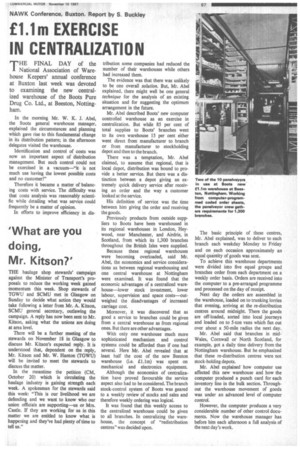film EXERCISE IN CENTRALIZATION
Page 89

If you've noticed an error in this article please click here to report it so we can fix it.
THE FINAL DAY of the National Association of Warehouse Keepers' annual conference at Buxton last week was devoted to examining the new centralized warehouse of the Boots Pure Drug Co. Ltd., at Beeston, Nottingham.
In the morning Mr. W. K. J. Abel, the Boots general warehouse manager, explained the circumstances and planning which gave rise to this fundamental change in its distribution pattern; in the afternoon delegates visited the warehouse.
Identification and control of costs was now an important aspect of distribution management. But such control could not be exercised in a vacuum—"it is not much use having the lowest possible costs and no customer!"
Therefore it became a matter of balancing costs with service. The difficulty was that costs analysis was reasonably scientific while detailing what was service could frequently be a matter of opinion.
In efforts to improve efficiency in dis tribution some companies had reduced the number of their warehouses while others had increased them.
The evidence was that there was unlikely to be one overall solution. But, Mr. Abel explained, there might well be one general technique for the analysis of an existing situation and for suggesting the optimum arrangement in the future.
Mr. Abel described Boots' new computer controlled warehouse as an exercise in centralization. But while 85 per cent of total supplies to Boots' branches went to its own warehouse 15 per cent either went direct from manufacturer to branch or from manufacturer to stockholding depot and then to the branch.
There was a temptation, Mr. Abel claimed, to assume that regional, that is local depot, distribution was bound to provide a better service. But there was a distinction between a depot giving an extremely quick delivery service after receiving an order and the way a customer looked at the service.
His definition of service was the time between him giving the order and receiving the goods.
Previously products from outside suppliers to Boots have been warehoused in its regional warehouses in London, Heywood, near Manchester, and Airdrie, in Scotland, from which its 1,300 branches throughout the British Isles were supplied.
Because these regional warehouses were becoming overloaded, said Mr. Abel, the economics and service considerations as between regional warehousing and one central warehouse at Nottingham were examined. It was found that the economic advantages of a centralized warehouse—lower stock investment, lower labour, supervision and space costs—outweighed the disadvantages of increased carriage cost.
Moreover, it was discovered that as good a service to branches could be given from a central warehouse as from regional ones. But there are other advantages.
With only one warehouse much more sophisticated mechanism and control systems could be afforded than if one had several. Here Mr. Abel revealed that at least half the cost of the new Beeston warehouse (i.e. £1.1m) was spent on mechanical and electronics equipment.
Although the economics of centralization have proved favourable the service aspect also had to be considered. The branch stock-control system of Boots was geared to a weekly review of stocks and sales and therefore weekly ordering was logical.
It was found that this weekly access to the centralized warehouse could be given to all branches. In centralizing the warehouse, the concept of "redistribution. centres" was decided upon. The basic principle of these centres, Mr. Abel explained, was to deliver to each branch each weekday Monday to Friday and on each occasion approximately an equal quantity of goods was sent.
To achieve this warehouse departments were divided into five equal groups and branches order from each department on a weekly order basis. Orders are received into the computer to a pre-arranged programme and processed on the day of receipt.
Next day the orders are assembled in the warehouse, loaded on to franking lorries that evening, arriving at the re-distribution centres around midnight. There the goods are off-loaded, sorted into local journeys and loaded on to 5-ton vans which fan out over about a 50-mile radius the next day.
Mr. Abel said that branches in midWales, Cornwall or North Scotland, for example, got a daily time delivery from the Nottingham warehouse. But he emphasized that these re-distribution centres were not stock-holding depots.
Mr. Abel explained how computer use affected this new warehouse and how the computer produced a punch card for each inventory line in the bulk section. Throughout the warehouse movement of goods was under an advanced level of computer control.
However, the computer produces a very considerable number of other control documents. Now the warehouse manager has before him each afternoon a full analysis of the next day's work.




































































































































































































































































